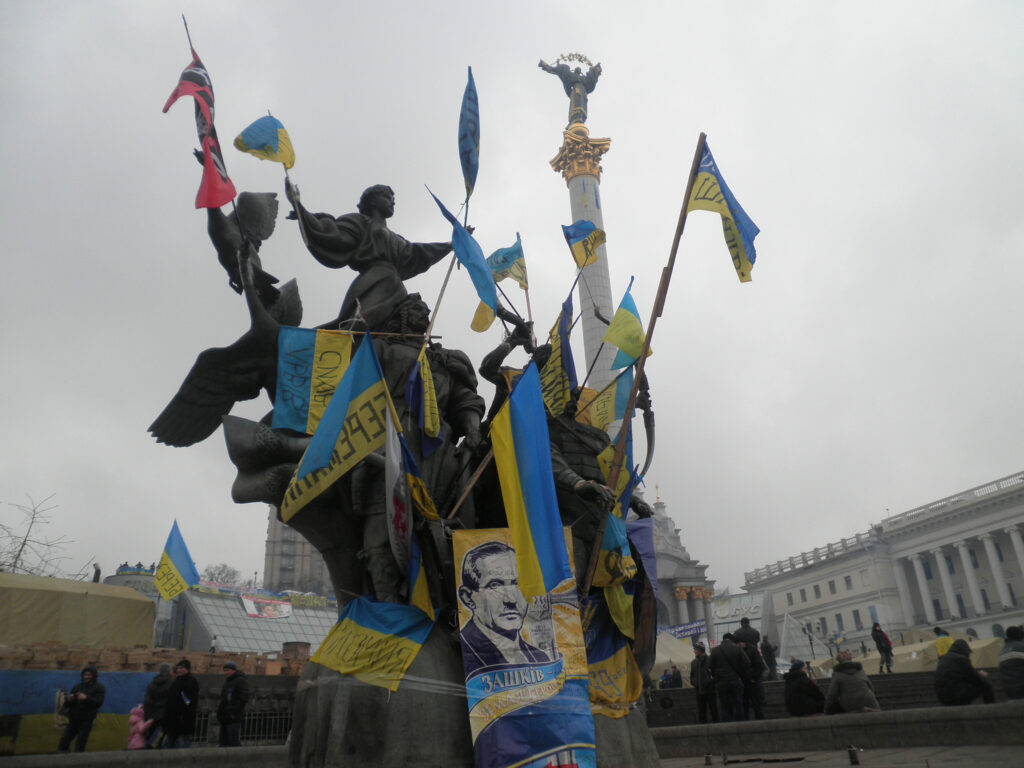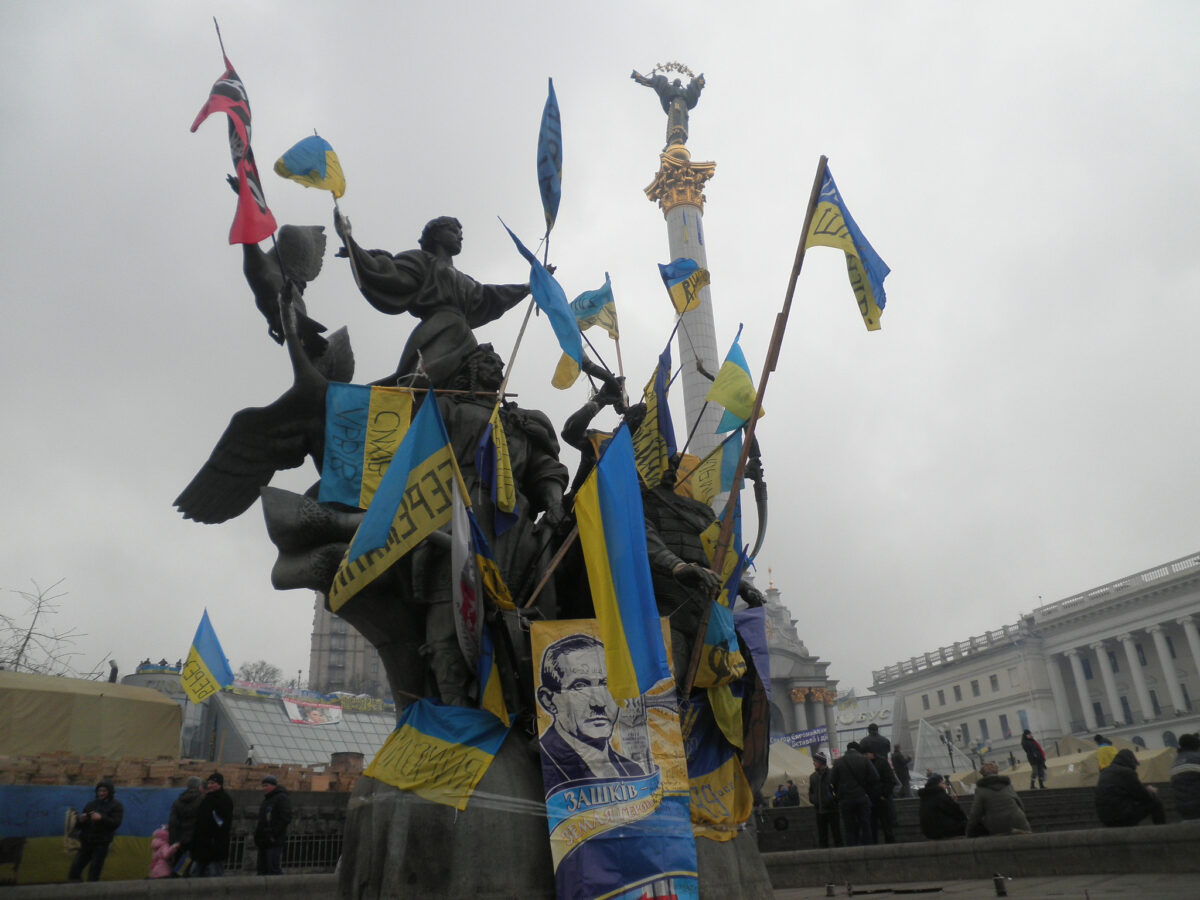Note from LeftEast editors: This is a slightly edited version of an earlier published text in German: Ishchenko, V. (October 15, 2021). Die Ukraine im Teufelkreis der post-sowjetischen Hegemonie-Krise. Ukraine-Analysen, 256, 8-10.
After the 30 years after the dissolution of the Soviet Union, Ukraine may give a unique perspective on the post-Soviet condition in general and understand it as the ongoing unresolved crisis of the fundamental relation of representation between the political elites and social groups interests. In economics, de-modernization and peripheralization make Ukraine, perhaps, the best candidate to be called the northernmost country of the Global South. Starting from the basic indicators such as GDP per capita to the most urgent ones like the share of COVID-vaccinated population, Ukraine lags behind of usually all of its Central and Eastern European neighborhood. In politics, the caleidoscope of short-lived governments, personalistic, frequently re-branding but poorly distinguished ideologically political parties, the patronal “oligarchic” networks have been competing and exploiting the weakening state institutions. The latter is under the intensifying pressure of civil society that has remained “narrow” in the sense of institutionalizing the public activity of more than a small minority of Ukraine’s citizens and representing the interests of social groups constituting Ukrainian society. In culture, the shaky and short-lived unifying trends combined with the parallel polarization leave the country fragmented and divided rather than consolidated in the inclusive civic nation (Zhuravlev & Ishchenko, 2020). Internationally, Ukraine is stuck between adverse Russia and non-accepting EU and NATO.
This is the case despite (and as a result of) the three revolutions during the span of a single Ukrainian generation (in 1990, 2004, 2014). Many have seen these revolutions as breaking with the Soviet/post-Soviet condition. But, in reality, they were only reproducing and intensifying the very crisis, which is the nature of post-Soviet condition. Maidan revolutions were deficient solutions exacerbating the very problem they were responding to.

Thirty years ago, the dominant expectation about the post-Soviet countries was democratization and “return to the main road of civilization.” In this perspective, Ukraine was supposed to follow the path of their East European neighbors and, perhaps, after a series of revolutions, the “postponed” 1989 moments, join the ranks of the success stories of internalization and integration into Western institutions.
As time passed, more critical perspectives on post-Soviet transformation gained prominence. Now, it was not the post-Soviet countries that were following the path of the EU-integrated Eastern Europe but, perhaps, the other way around, as Kaczynski’s Poland and Orban’s Hungary have joined the “illiberal” club of Putin’s Russia and Lukashenka’s Belarus. From this perspective, Ukraine is just a weaker version of a “competitive,” “electoral,” or other “hybrid” form of an authoritarian regime that has never been able to consolidate because of the national identity cleavage, oligarchic pluralism, and other Ukrainian peculiarities.
Some have called to abandon any generalizing views on the post-Soviet condition as the countries in the space between Estonia and Tajikistan have become too divergent. However, the problem of indefinability may be solved if we look at the post-Soviet dynamics without wearing teleological glasses. What if the post-Soviet countries have not been “moving” anywhere at all but have been stuck in the continuing crisis that had started even before the Soviet collapse? The unresolved character of the crisis is then the defining characteristic of the post-Soviet condition.
What are the benefits of looking at the post-Soviet condition as a crisis?
Firstly, we stop reproducing teleological ideologies that are either dominant in either post-Soviet civil societies or exploited by authoritarian leaders. Perhaps, we are moving nowhere or down to the abyss, rather than back to the “main road of civilization” or forward on our “sovereign” path under the direction of authoritarian leaders.
Secondly, it widens the time frames of our analysis. The dissolution of the Soviet Union in 1991 is not a starting point anymore but one of the transfer stations and not an event of a particular rupture. The centrifugal de-modernizing disintegration of the centrally planned economy and the political elite at the top of the Communist Party, which led to the economic collapse in the 1990s, started well before 1991. Precisely this lack of the revolutionary rupture during the Soviet collapse has been exploited to justify the need for more “real” (and also violent) revolutions later. However, contrary to the civil society’s teleological ideology, this is not a continuity with the Soviet structures (the notorious sovok) resisting the return to “normal life” but the degraded Soviet structures that have been declining since the end of the 1960s and have not been replaced by any stable modern structures since then.
With the incapacity to integrate the activization during the Thaw in mid 1950-60s and give a new impulse to the Communist Party structures, the fundamental relation of representation between the political elite and the society in the Soviet Union was broken and has not been restored since then in post-Soviet countries. No elite group could successfully articulate its particular interests in terms of the interests of the entire ruling class and the subaltern classes and mobilize their rational, active, participatory consent with their leadership in modernizing the countries. Following Gramsci, Oleg Zhuravlev and I analyze this process as the crisis of hegemony (Ishchenko & Zhuravlev, forthcoming). No other hegemony replaced the Communist hegemony when it degraded during Brezhnev’s years.
There are several reasons for this. The post-Soviet ruling class of political capitalists was born in the process of rapid and arbitrary privatization of state property, for which no ideological, religious, traditional sources of legitimation existed in the late Soviet societies, and is still widely perceived as “theft” or “corruption.” The post-Soviet maidan revolutions were a threat at most to the individual elite groups to be replaced by a rivaling elite group but never presented an existential threat to the ruling class to force it to “lead” subaltern classes, not simply dominate them. The political representation of the social groups’ interests has been undermined both “from above” and “from below.” The main parties of the ruling elites reproduced and exacerbated the viсes of the late-Brezhnevist Communist Party – meaningless ideology, patronalism, little activist participation. The de-modernizing disintegration left the social interests of the groups constituting post-Soviet societies poorly articulated and organized. The gap between the immediate interests of a regular person and any politics or ideology has only widened.
Finally, the perspective of the post-Soviet condition as crisis gives a new angle on the interdependence between the seemingly divergent political trajectories among the post-Soviet non-EU countries: in the larger group with consolidated authoritarian regimes (Russia, Belarus, Azerbaijan, and most of Central Asia) and in a smaller group that retained pluralism and experienced revolutions (Ukraine, Moldova, Georgia, Armenia, Kyrgyzstan), among which Euromaidan has been so far the most massive, long-lasting and violent. These groups exemplify two main deficient solutions to the post-Soviet crisis of hegemony. Both the post-Soviet Caesarist/Bonapartist regimes and the maidan revolutions respond to the same crisis, which they are not able to overcome, and that forms the ground for their commonality and interconnection.
Putin’s or Lukashenka’s regimes are not simply a patronage network capturing the state and leaving the legitimacy of this “mafia state” unexplained. Instead, they unify the disintegrating ruling class by coercing the dissenting elite factions and balancing the interests of others. They draw their legitimacy from restoring and sustaining stability amidst the post-Soviet chaotic disintegration. They are usually capable of securing the electoral majorities’ passive consent but fail to form and institutionalize the active consent with their rule. This results in recurring crises of succession that create a vulnerability point and reveal the deficiency of Caesarist solution, which needs to rely even more on coercion to prevent the maidan threat.
At the same time, the maidan revolutions are not simply the breakdowns of such regimes or the failed attempts to even construct them. Maidans are perceived as revolutions that would break with the post-Soviet condition and would not lead simply to another cycle of elite circulation. However, the revolutionary rhetoric and tactics are used only with poorly articulated social claims, loose structures of organization and mobilization, and dispersed leadership. The result is not revolutionary transformation but only revolutionary legitimacy to be hijacked by political agents representing the revolutionary base no better than those overthrown by the very revolution. In this way, the post-Euromaidan governments got into a trap between: 1) inflated, however poorly articulated and organized social interests, 2) the empowered, however, not expanded civil society with its unpopular national-(neo)liberal agenda, 3) the contradictory interests of the unchallenged local ruling class of political capitalists and of transnational capital, and 4) the geopolitical conflict between the West and Russia. The nationalist radicalization should have compensated for the unmet revolutionary expectations; however, it led Petro Poroshenko to his devastating defeat in the 2019 elections. Volodymyr Zelenskyi’s “new face” was a perfect symptom of both the intensifying crisis of representation and, at the same, demonstrated the difficulty to break from the confines of the post-Euromaidan trap, which he can only rush around applying selective and inconsistent repression against the opposition but will hardly be successful in consolidating Caesarist regime.
If post-Soviet Caesarism simply conserves the crisis of hegemony, maidans respond to the crisis but in a way that only reproduces and intensifies the very crisis. However, post-Euromaidan Ukraine may also point to the exit from this vicious post-Soviet circle of deficient solutions. The diminished internal and external autonomy of the state makes Ukrainian political capitalists more vulnerable to be outcompeted and marginalized by transnational capital – reflected in their vehement resistance to “anti-corruption.” This existential threat – that neither of maidans has ever posed – may force the post-Soviet ruling class to engage in more active attempts to unite, articulate, and pursue the interests of their own and subaltern classes. In its own turn, more successful hegemonic politics from above could give a model and open opportunities for counter-hegemony from below.
References
Ishchenko, V., & Zhuravlev, O. (forthcoming). Post-Soviet vicious circle: Revolution as reproduction of the crisis of hegemony. In D. J. Riley & M. Santoro (Eds.), The Anthem Companion on Gramsci. Anthem Press.
Zhuravlev, O., & Ishchenko, V. (2020). Exclusiveness of civic nationalism: Euromaidan eventful nationalism in Ukraine. Post-Soviet Affairs, 36(3), 226–245.


